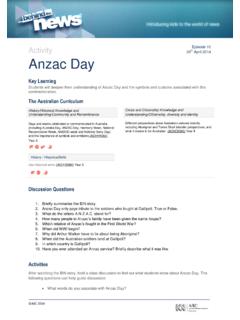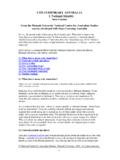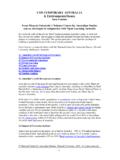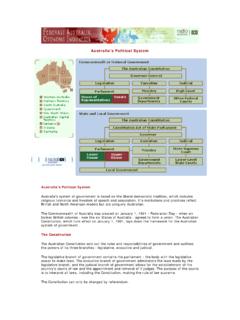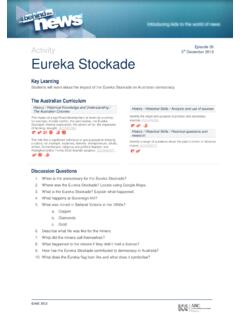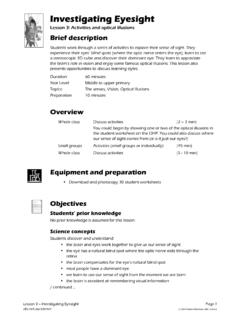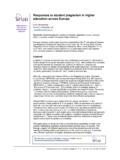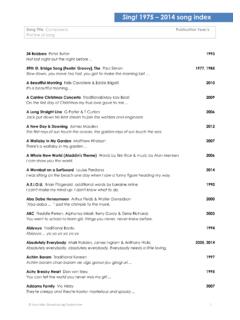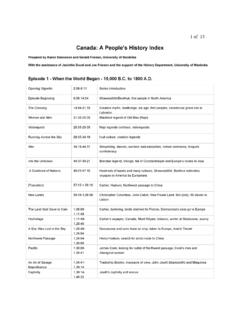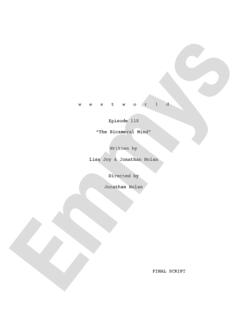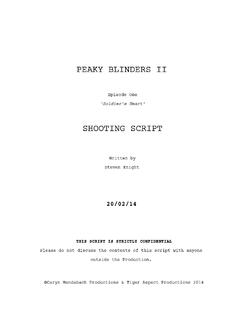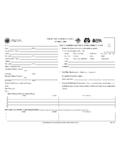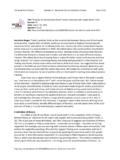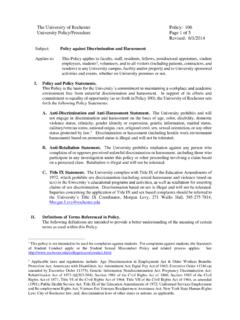Transcription of Episode 20 Bee Problems - ABC
1 ABC 2014 Activity Bee Problems Key Learning Students will research information about bees play and create a report and a labelled diagram. The Australian Curriculum Discussion Questions 1. Briefly summarise the BtN story. 2. What protective clothing do you need to wear if you are handling bees? 3. What do the bees collect to make honey? 4. Where is the nectar stored to make honey? 5. It s thought that the pollination done by bees provides about a _____ of the world s food. 6. The Varroa mite has spread to Australia. True or false? 7. Why are beekeepers worried about the Varroa mite? 8. Why do the kids in the BtN story like beekeeping? 9. Why is it important to protect bees? 10. Create a facts chart about bees and beekeeping. Activities Key words Students will find out what the following key words mean.
2 Science / Science Understanding / Biological sciences English/Literacy/Creating text Living things have life cycles (ACSSU072) Year4 Living things, including plants and animals, depend on each other and the environment to survive (ACSSU073) Year 4 Plan, draft and publish imaginative, informative and persuasive texts containing key information and supporting details for a widening range of audiences, demonstrating increasing control over text structures and language features (ACELY1694) Year 4 Episode 20 29th July 2014 Apiarist Pollinate Colony Ecology Parasite Nectar ABC 2014 Class Discussion What do you know about bees? Hold a class discussion to find out what students know about bees. Using sticky notes, students write down a piece of information they know about bees.
3 Collect and place all the notes on a wall in the classroom. The following questions may help generate discussion: Information Report Students will write an information report about bees. Using the information discussed and recorded earlier The following may help guide students research: Description of a bee Diet, habitat What are the different roles bees have in the colony The life cycle of a bee Important role in agriculture Threats to bees Interesting facts about bees Structure and features of an information report Discuss with students what they already know about the purpose, structure and features of an information report. Use the following as a guide to use with students. Purpose An information report provides information to the reader by stating facts.
4 Structure Introduction - the opening statement explains the subject of the report, and includes a definition or short description. Description the body of the report is a series of paragraphs giving information. Conclusion a summary of what has been said. Language features Present tense Technical or scientific words Written in the third person They can then use the following plan to help them write their report. There are some website links at the end of this activity to help students with their research. Why do bees pollinate flowers? What parts of the bee are involved in pollination? Why is pollination important to agriculture? What jobs do different bees have in the colony? What is a hive? What happens inside a hive? How do honey bees communicate? Why is it important for bees to communicate?
5 What makes the nectar change into honey? ABC 2014 Information report plan Headings Key words Definition Description Important facts about the subject in paragraphs Summarising comment Students can present their reports using publishing software or as a brochure. Create a labelled diagram Self assessment Parts of the activity I enjoyed Parts of the activity I found challenging Parts of the activity I found interesting Students create a labelled diagram of a bee. Include: A title An accurate drawing, A scale to show the object s size Labels showing the main features Body parts to include: Antennae, wing, pollen sac, proboscis, stinger, abdomen, head, thorax, eye Further Investigation Research and find a close up image of bees collecting pollen.
6 Describe what you see. ABC 2014 Further Investigation Investigate what kinds of bee-friendly plants grow in your area design and plant a bee garden. Research the process of extracting honey from bee hives. Explain the process using words and pictures. Related Research Links Behind the News Backyard Bees ABC News Parasite could threaten WA bees Australian Museum Australian Honey Bee National Geographic Honey bee ABC Gardening Australia Backyard Beekeeping Australian Museum - Bees collecting pollen Internet 4 Classrooms Learn about a bee History of Australian bees
